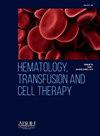PREPARATION OF 1-[18F]FLUORO-2-IODOETHANE AS A PROSTHETIC GROUP FOR [18F]FLUOROETILATION
IF 1.8
Q3 HEMATOLOGY
引用次数: 0
Abstract
Introduction/Justification
[18F]Fluorine is of considerable importance in radiochemistry for positron emission tomography (PET) due to its decay characteristics (18F; beta+ 96.7%, T1 = 2. 109:8 min). Numerous methods for introducing 18F into organic molecules have been developed, with alkylation being one of the methods. Thus, developing the radiochemistry process for the fluorination of dihaloalkyl compounds is a crucial step for the development of new radiotracers.
Objectives
This work aims to prepare the 1-[18F]fluoro-2-iodo-ethane as a prosthetic group for radiolabeling amine or alcohol functionalized molecules, focusing on developing the radiotracers for molecular imaging.
Materials and Methods
[18F]Fluoride was produced by the 18O(p,n)18F reaction on [18O]water using cyclotron (GE 16.5 MeV). Radiolabeling method 1: [18F]Fluoride was trapped in a QMA cartridge and released by eluting tetraethylammonium bicarbonate (TEAHCO3 (7.5 mg, 2.47 μmol) in methanol into a vial. The methanol solution was heated at 100oC with a gentle stream of N2 until methanol was evaporated. Acetonitrile (AcN) was added (0.5 mL × 2) and evaporated to complete drying the system. A solution containing 9 mg (3.19 μmol) of 1,2-diiodoethane in 0.5 mL AcN was added and heated at 100oC for 10 or 15 min. Radiolabeling method 2: Water solution containing [18F]fluoride was added to a vial and dried by azeotropic evaporation with acetonitrile (0.5 mL × 2) at 100 oC with a gentle stream of N2 over 10 min. An acetonitrile solution containing TEAHCO3 (7.5 mg, 2.47 μmol) or TBAHSO4 (8.3 mg, 2.47 μmol) was added and evaporated; finally, 9 mg (3.19 μmol) of 1,2-diiodoethane in 0.5 mL of AcN was added and heated at 100oC for 10 min. At the end of the reactions, vials were allowed to reach room temperature; a sample was removed and analyzed in TLC-SG and TLC-RPc18 using ethyl acetate or ethanol as the mobile phase. [18F]fluoride ion and [18F]fluoride/ammonium quaternary ion pair were also analyzed by TLC chromatography. Stripes were cut in segments of 1 cm and read in a well counter.
Results
All the chromatographic systems evaluated presented [18F]fluoride and [18F]fluoride/ammonium quaternary retained in the origin of the systems. Samples of the reaction showed a radioactive product moving to the front of the TLC-RPc18 using ethanol, and this TLC system was used to analyze the reaction efficiency. Radiochemical yield was calculated considering the Rf 0.5-1.0 radioactive counts in the TLC-RPc18/EtOH. Reaction under condition 1: heating time: 10 min = 24.5%, 15 min = 10.6%. Reaction under condition 2: TEAHCO3 - 10 min = 47.6%, TBAHSO4 - 10 min = 24.8%.
Conclusion
The results demonstrated the feasibility to produce 1-[18F]fluoro-2-iodo-ethane by both techniques, and heating time and kind of ammonium salt can influence the reaction yield. Directly adding [18F]fluoride to the vial, without using a QMA cartridge, seems to be a good alternative to optimize multiple reaction parameters in the radiolabeling process. This route will be used to optimize parameters for the proposed reaction and for other dihaloalkyl molecules.
求助全文
约1分钟内获得全文
求助全文
来源期刊

Hematology, Transfusion and Cell Therapy
Multiple-
CiteScore
2.40
自引率
4.80%
发文量
1419
审稿时长
30 weeks
 求助内容:
求助内容: 应助结果提醒方式:
应助结果提醒方式:


